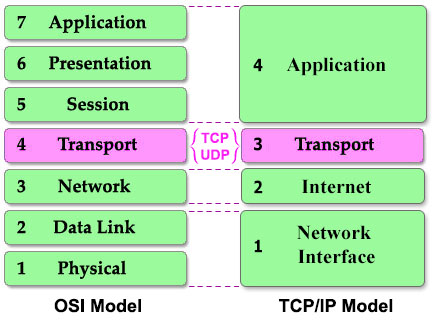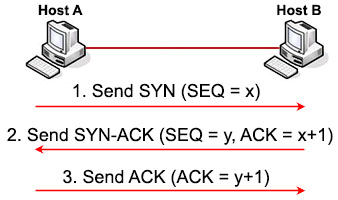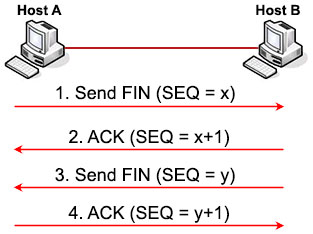TCP and UDP Tutorial
The Transmission Control Protocol (TCP) and User Datagram Protocol (UDP) are the two most popular protocols in the transport layer. They ensures that messages are delivered error-free, in sequence, and with no losses or duplication. The key difference between TCP and UDP is that TCP provides a wide variety of services to applications, whereas UDP does not. At the result of this, TCP is much more complex than UDP so this tutorial is dedicated to explore TCP in detail but we still compare them.

Both TCP and UDP are protocols at the Transport layer (of both OSI and TCP/IP model) but why we need both of them? The answer is:
+ TCP is slower but reliable
+ UDP is faster but unreliable
In most cases we will want to be reliable in web accessing, email communicating, file uploading… as we don’t expect a few corrupted packets would destroy our whole work. With TCP, these corrupted packets will be resent or repaired to make sure everything is correct. Yes, TCP is really nice to ensure your work is accurate!
But with a price…
To guarantee the sending segments is free of error, TCP adds some bits for tracking and checking purpose so that the other end can verify and ask for missing pieces of segments. As a result of this, the segments become larger, consume more bandwidth and CPU resources to proceed.
Although UDP cannot guarantee everything is accurate like TCP but UDP is faster than TCP because it does not require additional bits for tracking and checking purpose. So which tasks need speed? Video (streaming) and audio are ideal for this task because they are considered real-time applications. Suppose you are talking to your friend, surely you want your voice to reach your friend without any delay. It would be very weird if your friend can only hear your voice after a few seconds.
| Note: Segment is the name of the data packet at Transport layer |
TCP can also slow down the transmission if it sees the path to the destination is too crowded. You don’t want TCP to slow down your voice in traffic-jam hours either. For example when you say “Hello, how are you?”, your friend at the other end may hear “Hellooooo,…… hooooooooow arrrrrrrre yyyyyoou”. What is an awful conversation!
Losing a few packets for voice or video is acceptable. For example if you say the word “Hello” in one second, an IP phone generates about 25 to 100 packets (just an estimation, it depends on the codec and sampling frequency) so your friend can still understand what you say even if a few packets are missing. Moreover, re-transmission the missing packets is not useful as voice and video are real-time applications and the receiving end cannot wait for the missing segments to be resent.
So now we have some basic understanding of TCP and UDP. In the next part we will learn more about TCP. Let’s start with how TCP set up and terminate a connection.
TCP three-way handshake (to start the communication)
Suppose host A wants to start communicating with host B using TCP. Before they can send real data, a three-way handshake must be established first. Let’s see how this process takes place:

1. First host A will send a SYN message (a TCP segment with SYN flag set to 1, SYN is short for SYNchronize) to indicate it wants to setup a connection with host B. This message includes a sequence (SEQ) number for tracking purpose. This sequence number can be any 32-bit number (range from 0 to 232) so we use “x” to represent it.
2. After receiving SYN message from host A, host B replies with SYN-ACK message (some books may call it “SYN/ACK” or “SYN, ACK” message. ACK is short for ACKnowledge). This message includes a SYN sequence number and an ACK number:
+ SYN sequence number (let’s called it “y”) is a random number and does not have any relationship with Host A’s SYN SEQ number.
+ ACK number is the next number of Host A’s SYN sequence number it received, so we represent it with “x+1”. It means “I received your part. Now send me the next part (x + 1)”.
The SYN-ACK message indicates host B accepts to talk to host A (via ACK part). And ask if host A still wants to talk to it as well (via SYN part).
3. After Host A received the SYN-ACK message from host B, it sends an ACK message with ACK number “y+1” to host B. This confirms host A still wants to talk to host B.
If you are still unclear about this process, let’s assign: x = 1 and y = 50:

In this process, three messages need to be sent so we often call it “three-way handshake”.
Nice, now you really understand TCP three-way handshake, right? Host A can start sending real traffic to host B after the three-way handshake process.
TCP also does nearly the same thing when one end wants to terminate the connection with TCP four-way termination process.
TCP four-way termination (to end the communication)

Suppose Host A wants to end the connection to host B, Host A will send a FIN message (a TCP segment with FIN flag set to 1), FIN is short for FINISH. The purpose of FIN message is to enable TCP to gracefully terminate an established connection. Host A then enters a state called the FIN-WAIT state. In FIN-WAIT state, Host A continues to receive TCP segments from Host B and proceed the segments already in the queue, but Host A will not send any additional data.
Device B will confirm it has received the FIN message with an ACK (with sequence x+1). From this point, Host B will no longer accept data from Host A. Host B can continue sending data to Host A. If Host B does not have any more data to send, it will also terminate the connection by sending a FIN message. Host A will then ACK that segment and terminate the connection.
TCP requires to establish and terminate the connection before and after exchanging real traffic so it is called connection-oriented protocol. UDP does not support these features so it is called connectionless protocol.
More formally, these terms can be defined as follows:
+ Connection-oriented protocol: requires a logical connection to be established between the two processes before data is exchanged
+ Connectionless protocol: allow data to be exchanged without setting up a link between processes
In conclusion, TCP requires the establishment (via three-way handshake) and termination (via four-way termination) of a connection. In the next part we will learn about popular TCP features.



Can i am taking my CCNA 200-125 in 2 days… Can someone send me dumps? pilotishak @ gmail(dot)com
Kindly send CCNA latest dumps at haseebfarooq585 at gmail dot com
Please send me the recent dump for CCNA 200-125 beckz.t.r /gmail / com
Test coming up next month.
please send me CCNA latest dumps {email not allowed}
mgrmlj89/gmail/com
there is a very good explain about TCP/UDP protocols – I am impressed
Please send dumps for CCNA 200-125 to
aspirantisee (at) gmail.com
Can someone send me CCNA 200-125 dumps on soroyesaheedgmail.com
I used to prepare for my MCSD Developing Windows Azure and Web Services exam. It helped me secure 97% marks and was the only result of the 100% real exam materials I got from dumpstool.com
I learned CCNA before 5 years but again I am interested to learn. Provide me the details website address or send me a pdf to learn ccna and all networking. My question?
How to be a expert in CCNA / Networking world??
Taking the ccna 200-125 please send me the dump to benardtuju/yah/com
Please send me dump 200-105 dump, I do have an exam coming Friday. Thank you in advance. {email not allowed}. Thank you in advance
Very helpful article
can someone send CCNA 200-301 dumps to earvinaiken / gmail / com
i have 2 months to prepare for CCNA but i don’t know where to read the book after i finish vlan chapter, guys plz tell me what should i read for the next chapter? thank you
Hi can you Kindly send CCNA latest dumps at mohdadil99 at yahoo dot co dot uk
Need to latest dumps paper for ccna exam
Anyone can share ccna 200-301 latest dumps?
litttleyk/gmail/com
Can anyone share ccna 200-301 butch_drew/yahoodotcom?
Can anyone share ccna 200-301 dump alekosrapanakis/gmal/com
Please could you send me the recent dumps of ccna 200-301 to maikel.viltres from gmail.com
Please i am really in dying need for a support i and learning to write CCNA but confused along the study path. anyone who want to graciously help me is welcome
Eben send email or smt i am taking the exam this month and if u still need help i can help u with what i can.
Great, clear explanation of TCP and UDP.
Can anyone share ccna 200-301 dump 98jinhuck/naver/com